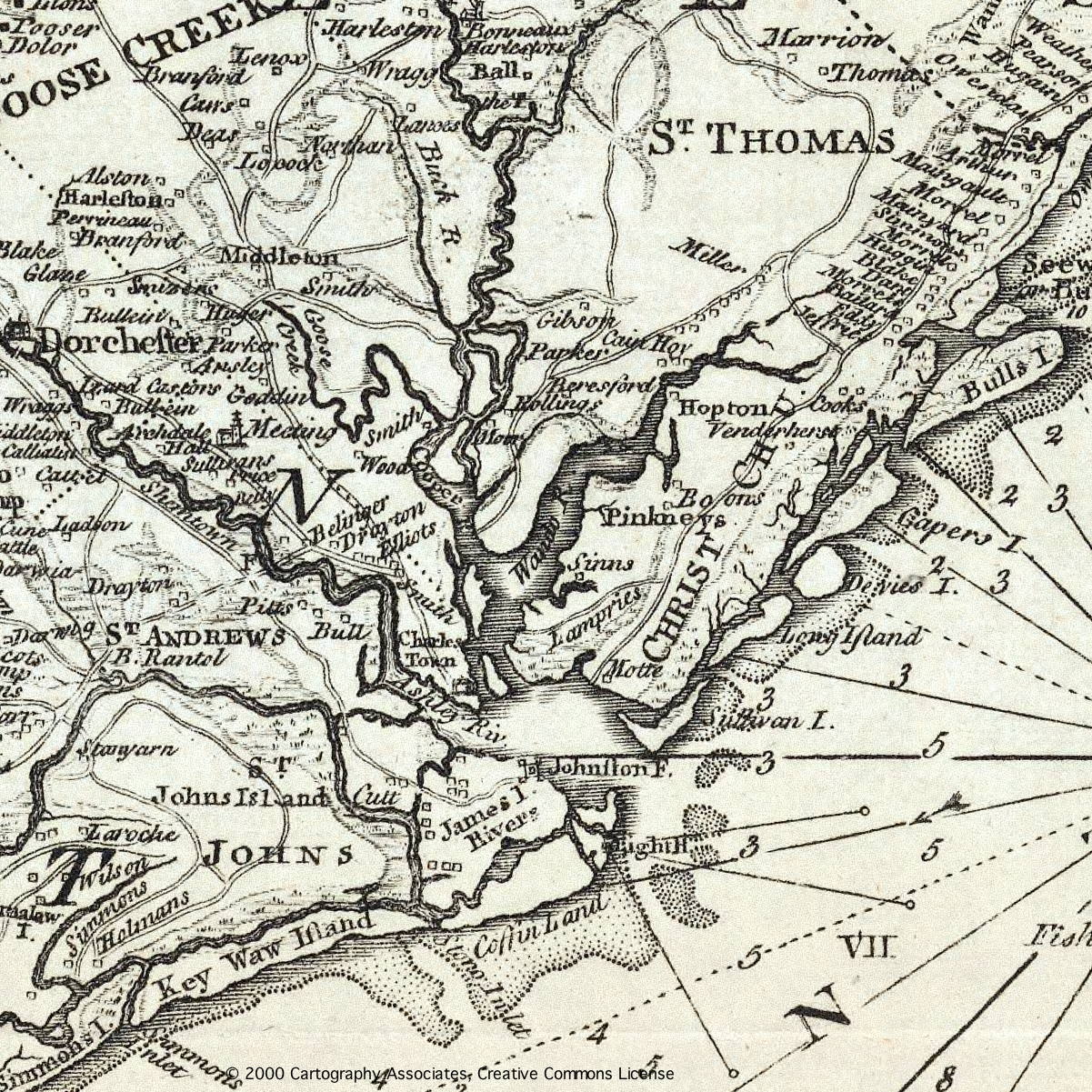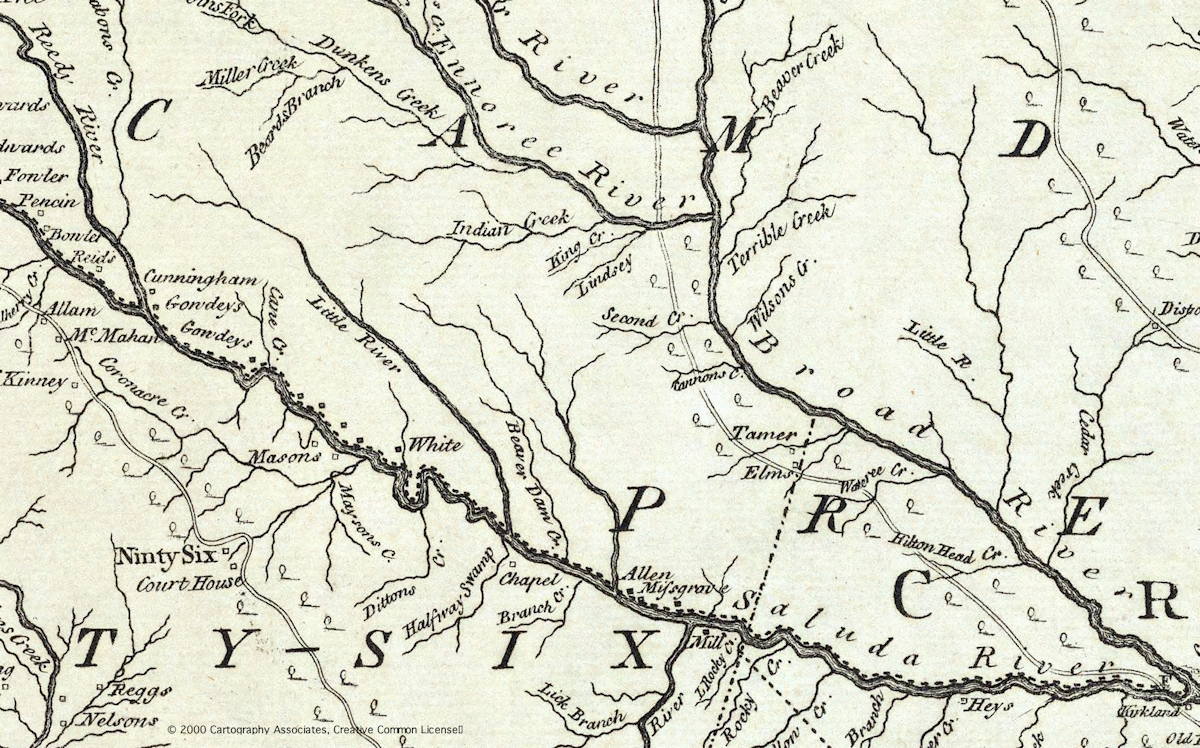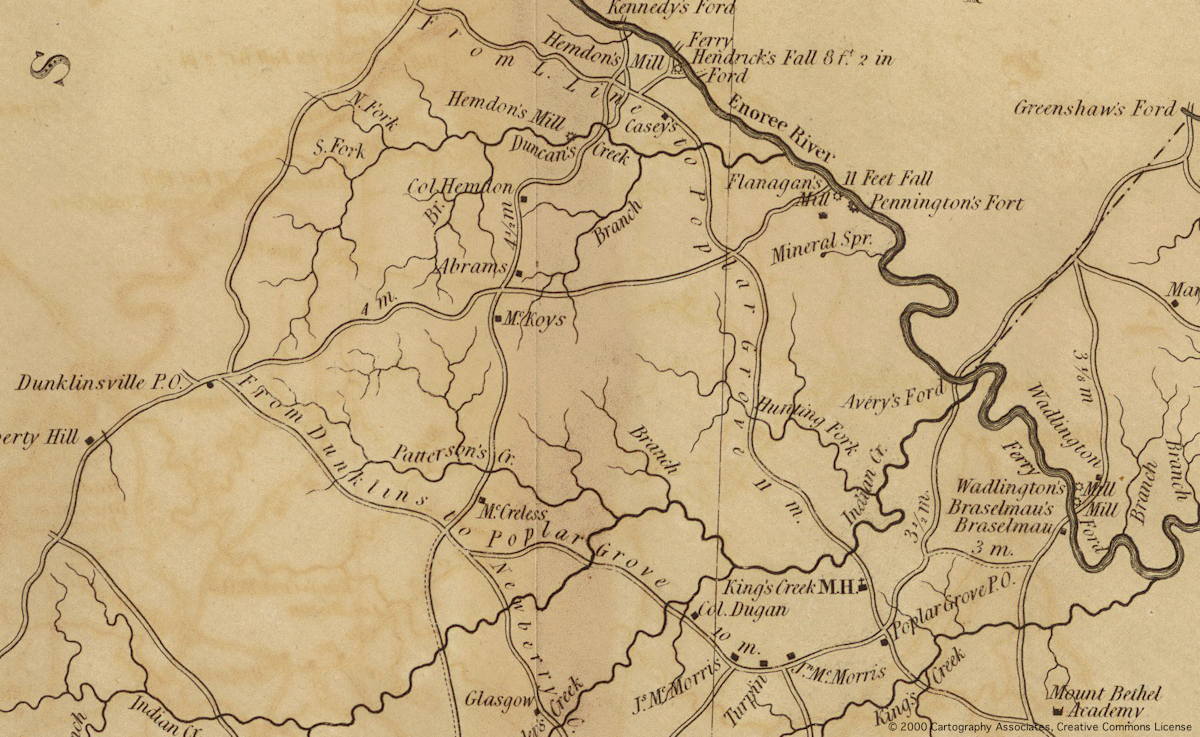The Bounty Act of South Carolina
In order to help settle unoccupied lands the General Assembly of the Colony of South Carolina provided financial aid to encourage the immigration of poor Protestants from Europe. As early as 1730, "poor Protestants" were given land if they settled it. The grantees were required to clear and cultivate the land at the rate of at least 3 acres per year for each 100 acres of land granted. After two years, the land owner was required to pay 4 shillings per 100 acres quit rent (essentially land taxes). The amount of land granted was 100 acres for the head of the household and 50 acres for each dependent (wife and children under 15). Although the land was free there were significant fees to be paid for surveys and other legal matters. However, the Governor could and often did waive or otherwise pay these fees for poor immigrants.
In 1752, the act was amended to provided money for tools and provisions. Each person under 50 years old and over 12 years old was given £5. Each person under 12 years, but over 2 years received 2 pounds 10 shillings. In 1761 the bounty was changed to provide money to defray the costs of passage from Europe. Each adult received £4 and each child received £2. Both received twenty shillings to purchase tools and provisions. To receive these benefits, immigrants were required to have certificates to show that they were of that religion and of good character.
"Warrants of Survey for their Lands" were issued on petition of the immigrants, generally at the same time, as authorized under the Act. Encouraged by the Act, large numbers of these protestant immigrants, many otherwise destitute, came to South Carolina, mostly from Europe, but also from other Colonies in America.
The acts that provided for these bounties were amended or expired and reinstated from time to time, but generally continued until 1768 when the Attorney General reported to the General Assembly that the "Bounty Act" had expired and no bounty could be paid to the individuals. He also noted that the eighth clause of the General Duty Act of June 14, 1751, that they were still entitled to "their land free of charge".
Source: Jean Stephenson, The Scotch-Irish Migration to South Carolina, 1772 (Rev. William Martin and His Five Shiploads of Settlers), Washington, DC, 1971, reprinted: Clearfield Company (General Publishing Co.) Baltimore, MD 1999 - 2008, ISBN-13:978-0-8063-4832-2 and ISBN-10: 0-8063-4832-1
South Carolina
William Boyd, born and married in County Antrim, Ireland, moved his family to South Carolina before the Revolutionary War. His nephew, Alexander, later came to South Carolina and lived with William. Many Protestants leaving Ireland during the 18th century to escape the economic and religious problems came to South Carolina because of the incentives provided by the Bounty Act.
On October 18, 1772, the James and Mary sailed into Charleston harbor, having spent the last 54 days at sea. The James and Mary was a three masted sailing ship called a snow1, and was captained by John Workman. They had departed from Larne, Ireland on August 25 with 32 families and 48 single persons on board — a total of 180 passengers. The passengers were all Scots-Irish immigrants who were coming to South Carolina to accept the free land being offered by the Province and to escape the poverty and hard times that were in northern Ireland. Of the 180 passengers that left Larne, only 175 arrived in Charleston, five children having died during the passage.

Charleston, SC 1773*
As eager as they must have been to get ashore, they had another six weeks to spend on the ship as there had been a severe outbreak of smallpox on board and the Governor of South Carolina ordered that the ship, its passengers and crew remain in quarantine, first for three weeks and then for an additional three weeks. During this period of quarantine, the sick were confined to a large house on Sullivan's Island which served as a hospital. In fact, this was probably the “Pest House”, built as a quarantine house more to protect the inhabitants of Charleston from infectious diseases arriving on ships than to provide medical services for the sick. Such Pest Houses were common in the American Ports of Entry in the 18th century. In addition to sick passengers, such as those on the James and Mary, all slaves arriving in Charleston aboard slave ships were quarantined on Sullivan's Island in the Pest House. The passengers on the ship were allowed ashore on Sullivan's Island, but were otherwise isolated. Sullivan's Island can be seen in the map below at the mouth of the harbor, on the north side. The quarantine ended around the end of November, for the Council Journal (the official record of the proceedings of the Governor's Council) has an entry on December 1 regarding the petition for land of the passengers on the ship.
The James and Mary was one of five ships that carried, mostly Presbyterian, Scots-Irish immigrants to South Carolina in the fall of 1772. The undertaking was organized by Reverend William Martin, a Reformed Presbyterian minister from Kellswater, County Antrim. The other 4 ships were delayed in departure and by weather and did not arrive until December 19, 20 and 22. The Pennsylvania Farmer arrived on December 19 with 215 passengers; the Lord Dunluce on December 20 with 394 passengers, and the Hopewell with 186 passengers and the Free Mason with 232 passengers both arrived on December 22. In all, the five ships brought over 1200 immigrants from Ireland.
William Boyd
William Boyd, his wife, Mary, and two daughters, Mary and Martha were among the passengers on the James and Mary. William was 27 years old. Mary, his wife was 29. Their eldest daughter, Mary, was 4 years old and Martha, the youngest, was less than 1 year. William was born in County Antrim Ireland about 1745. He had a brother named Robert. William and Robert were members of the Covenanter Church of Scotland (the Reformed Presbyterian Church) and probably lived in the area around Ballymena (William Martin was the minister at the Kellswater Reformed Presbyterian Church). Robert's son, Alexander, would come to America in 1790 and live with his Uncle William.
It was the custom, if the passengers were satisfied with the voyage, to write a letter for publication expressing their satisfaction. The following was published in the Belfast News Letter on Tuesday, 22 December 1772.
"To the Printers of the Belfast News Letter.
I desire you will insert and continue three times in your Paper, the inclosed Letter, which I received from South Carolina.
Yours,
James McVickar
Larne, 21 Dec. 1772
P. S. My Friend in Charlestown advises me, that they have a great Crop of Rice, but want Ships to carry it to Market.Charles-Town, Oct. 21 1772
To Mr. JAMES M'VICKAR, Merchant in Larne.
Sir
THESE will inform you, that we arrived here all well and in good spirits the 18th instant (five Children excepted who died in the Passage) after a pleasant and agreeable Passage of seven weeks and one day. — Pleasant with respect to Weather, and agreeable with regard to the Concord and Harmony that subsisted among us all: And, to confirm what we have heard you assert, before we left Ireland, we must say, that we had more than a sufficiency of all kinds of Provisions, and good in their kind: And to speak of Captain Workman, as he justly deserves, we must say with the greatest Truth (and likewise with the greatest Thanks and Gratitude to him) that he treated us all with the greatest Tenderness and Humanity: and seemed even desirous of obliging any one, whom it might be in his Power to serve. If you think proper, we would be desirous you should cause these Things to be inserted in the public News Letter, being sensible they will afford our Friends and Acquaintances great Satisfaction; and we hope they may be of some Use to you and Captain Workman, if you resolve to trade any more in the Passenger Way. Now, in Confirmation of these Things, We Subscribe ourselves as follows:We are, Sir, your Most humble Servants,
Revd Robt. McClintock John McClintock Thos. Makee John Dicky John Peddan James hood Wm. Anderson James Stinson Joseph Lowry John Montgomery John Thompson Peter Willey Timothy Mc.Clintock John Snody Hugh Loggan John Caldwell Nathan Brown Robt. Hadden David Thonmpson Samnuel Kerr Wm. Boyd Hugh Mansoad James Peddan Robt. Machesney Robt. Wilson Alex. Brown Wm. Eashler Robt. Ross John Brown Charles Miller John Parker Thomas Madill John rickey James Young Wm. Simpson Charles Dunlop Robt. Neile P. S. We had Sermon every Sabbath, which was great Satisfaction to us. We omitted to let you know, that the Mate, Mr. Bole, as also the common Hands, behaved with great Care and Benevolence towards us."2
Upon their release from quartine, the immigrants from the James and Mary petitioned the General Council for land. The entry in the South Carolina Council Journal on December 1, 1772 states:
"The following Persons presented Petitions setting forth that they were Protestants and had lately come to settle in this Province with their Respective Familys from Ireland and were desirous to settle and cultivate some vacant Land in the back parts of the Country. but by reason of their extreme Poverty they were altogether unable to pay the Fees due to the several offices for their Grants, and that they were in hopes to have received some aid from the Province as their Countrymen had hitherto done, and therefore Prayed his Excellency [the Governor] to Grant them such Relief as in his Goodness he should see fit.
His Excellency thereupon observed to them that the Bounty given by the Province had ceased long since, and that they had no Reason from Government to expect any such assistance as they Craved. But it appearing that they were very poor, his Excellency proposed to the several officers to deliver out their warrants without expense to them and to take the Risk of being paid by the Public which they severally agreed to . . . the Secretary was ordered to prepare the warrants of survey."1
The records indicate that William Boyd was granted 250 acres of land, which according the Bounty Act provisions would have been consistent with a male head of household (100 acres), a wife (50 acres) and two children (50 acres each). William and his family settled in Newberry District, SC. (There was also a William Boyd on the Hopewell who also received 250 acres, but he settled in Laurens county. The family history written by Robert B. Boyd indicated that our ancestor settled in Newberry District. Also, we have William Boyd's will, which refers to the land in Newberry County. There can be no doubt that this Chester County William Boyd is the correct one based on date of death and heirs, including children and grandchildren.)

Camden District, 1773*

Newberry District, 1825*
View Larger Map
William Boyd's land was located in what is now Newberry County but was then Berkeley County in Camden District. At the time, South Carolina was divided into only for counties. The land survey identified the particular plot of land as: "in Berkeley Co., in fork between Broad and Saluda, on branch of Patterson Creek called Scott Branch; waters of Enoree River; bd'd William Proctor, John Kennedy, vacant lands, Mr. Robert McClento, James Proctor, Alexander Turner, John Armstrong, William Scott." Patterson Creek is located between the Saluda and Broad Rivers and is about 5 miles in length, emptying into Indian Creek, which in turn flows to the Enoree River.
Fortunately, Pattersons Creek has not changed its name since 1772. Although not labeled in the 1773 map of South Carolina below, it is shown in the 1825 map of Newberry District. Only the larger streams are shown in these early maps of South Carolina. In the 1825 map, Pattersons Creek can be seen emptying into Indian Creek, which in turn empties into the Enoree River. Unfortunately, the branches are not named, so it's unknown which is Scotts Branch. More detailed maps are here.
Pattersons Creek is located in what is now Sumter National Forest about 10 miles north of Newberry, SC and shown on the map to the right. Pattersons Creek is shown as a green line with the source and mouth indicated with the arrows. William Boyd's land would have been somewhere between these two arrows. Other features in this map that are indicated with blue markers are the towns of Chester, Cornwell, and Blackstock, where several of the Boyds lived. Also shown are other rivers and streams in the area which relate to other families of interest (McCreights and McQuistons).
_________________________
1 A Snow (or snaw) is a sailing vessel, a type of brig. A snow carried square sails on the two masts and generally a trysail on the snowmast, which was abaft the main mast.
2 Jean Stephenson, The Scotch-Irish Migration to South Carolina, 1772 (Rev. William Martin and His Five Shiploads of Settlers), Washington, DC, 1971, reprinted for the Clearfield Company: General Publishing Co., Baltimore, MD, 1999 - 2008, ISBN-13:978-0-8063-4832-2 and ISBN-10: 0-8063-4832-1
_________________________
* These images are copyright © 2000 by Cartography Associates. Images may be reproduced or transmitted, but not for commercial use. For commercial use or commercial republication, contact mailto:carto@luna-img.com This work is licensed under a Creative Commons License. By downloading any of these images, you agree to the terms of that license.
Scotland | Ireland | South Carolina | Mississippi | Tennessee | Arkansas | Texas
